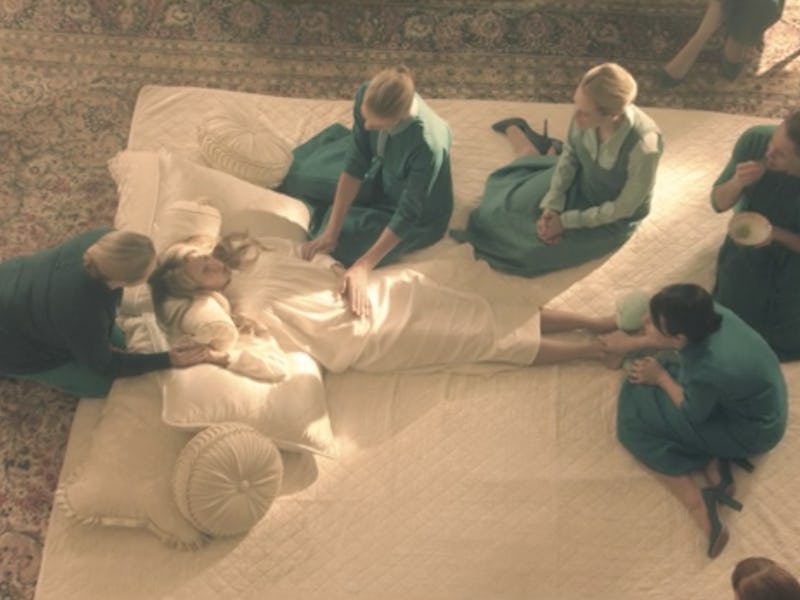Bizarre Handmaid’s Tale Pregnancy Scene Hints At Real-Life Fake Births

Of all the bizarre events that take place in Hulu’s haunting new adaptation of Margaret Atwood’s novel The Handmaid’s Tale, the fake group birth scene in Episode 2, “Birth Day,” is arguably the strangest. What makes it especially weird is that it resembles a phenomenon that occasionally takes place in real-life maternity wards.
Caution: Spoilers for The Handmaid’s Tale ahead.
In Atwood’s dystopian world, a mysterious illness has made fertile women scarce. Those who remain are coerced into becoming “two-legged wombs,” or Handmaids, whose only purpose in society is to give birth to babies for the sterile, blue-cloaked Wives. During birthing events, the center of focus is not the pregnant Handmaid but the very un-pregnant Wife, who spends the entire ceremony with her legs splayed and groaning in pain, as if she were, indeed, actually about to give birth. All the while, her fellow wives sit around her, gently coaching her to “breathe.”
The ridiculousness of this fakery gives less pious Handmaids reason to snicker, but when this phenomenon happens in real life, it’s taken as a sign of an actual medical condition.
In the fake birth scene in The Handmaid's Tale, this Wife is not actually pregant.
Doctors refer to it as “pseudocyesis” — colloquially it’s referred to as false pregnancy, phantom pregnancy, or hysterical pregnancy — and is reported to occur 1 to 6 times in every 22,000 births. Women with the condition aren’t actually pregnant, but they display many of the signs of carrying a child. The DSM-5, the authority on mental disorders, lists it as a “false belief” of pregnancy that may include the following:
[Abdominal] enlargement, reduced menstrual flow, amenorrhea, subjective sensation of fetal movement, nausea, breast engorgement and secretions, and labor pains at the expected date of delivery.
That’s a pretty extensive list of physical symptoms for a woman who isn’t actually pregnant, and doctors largely chalk them up to issues with the woman’s endocrine system, which is what regulates her hormones. A 2013 review in Reproductive Biology and Endocrinology explained that pseudocyesis might be caused by an overactive sympathetic system, dysfunctional central nervous system, and decreased regulation of gonadotropin-releasing hormone, which plays a key role in pregnancy. Whatever it is that causes those endocrine changes, however, is thought to at least be partially psychological.
While the Wife goes through a simulated delivery, her Handmaid goes through an actual one.
We may not know what’s going on hormonally in the Wives in The Handmaid’s Tale, but it’s clear they desperately want to have children; after all, men have taken away all their other reasons to live. Not surprisingly, an urgent desire to get pregnant or participate in another woman’s delivery are common characteristics in women with pseudocyesis.
In the journal Psychosomatics in 2006, Drexel University psychiatrist Biju Basil described a woman who went through a false delivery as her son’s girlfriend went into actual labor. “She started having labor pains. She had been pregnant before, and she said they felt exactly the same,” Basil said in an interview with the New York Times. “She even gave a ‘final push’ the way she had when she delivered her own children.” In the case study, Basil explained that the woman had wanted to plan a more active role in the child’s birth and upbringing.
A person’s endocrine system and mental state exist in a delicate feedback loop, and disrupting one can trigger significant changes in the other. That’s likely what goes on in the bodies and minds of women with pseudocyesis, though the phenomenon is still not fully understood because the condition is so rare. We can’t know for sure whether this is what’s actually going in that weird birth scene in Handmaid’s Tale, but it does force us to consider sympathizing, at least a little bit, with the Wives. While their gross abuse of the Handmaidens is despicable, we can’t discount their experience of the patriarchal authoritarian regime — in Atwood’s dystopian world, all women are ultimately victims.